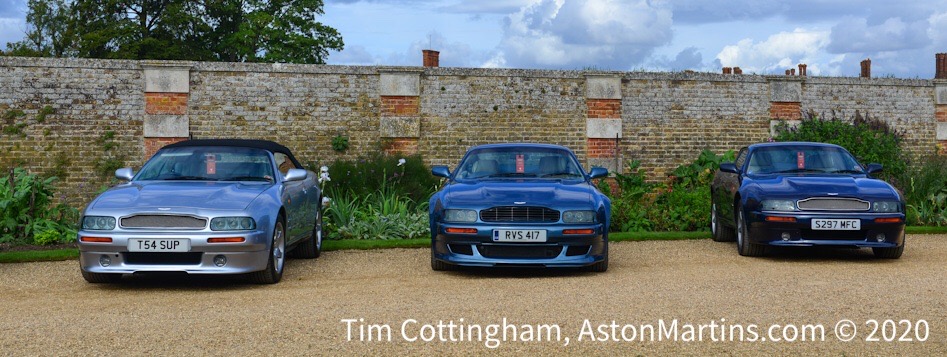Bulldog
- 25/01/2013Virage
- 16/08/2012Soon after the coupe was in full production it was joined by the convertible Volante version, initially shown with just two seats it was soon developed to carry four people in comfort. Finally, the mighty Vantage was unveiled in the Autumn of 1992; almost all of the panels were changed to create the most muscular Aston ever. The V8 was developed to produce an almost unbelievable 550 bhp assisted by twin Eaton superchargers.
Gradually the Virage was phased out and the standard car was restyled with many styling cues from the Vantage and called simply the V8 Coupe. Later, the V8 Volante also received the six headlights and ‘Jaffa’ grapefruit tail lights of the Vantage and had it’s wheelbase lengthened to give more space for the rear seat passengers; a real 4 seater family Aston
Works Service during the 1990’s offered optional enhancement packages for the V8’s. These have ranged from wide bodies, 6.3 litre engine conversions and on to full shooting brakes, 4 door supercharged saloons and the ultimate 600bhp V600 package for the Vantage.
The final version of the Virage, the V8 Vantage Le Mans, was made to commemorate the 40th Anniversary of the famous Aston Martin victory at Le Mans in 1959. Production was limited to just 40 cars. But even this was not quite the end; just 8 Vantage Volantes, built on the standard length chassis were completed in November 2000. These are now considered the pinnacle of coachbuilt V8 production.
Back on the other side of Tickford Street, Works Service were also busy building cars too in almost total secrecy. Only recently have AM even hinted at such special coachbuilt cars built at huge expense for extremely wealthy, Royalty and Heads of State. The full story was finally told in the book Aston Martin: Power, Beauty and Soul by my good friend, David Dowsey. I have now been given official access to the photographs of all of those special cars.
Throughout the 1990s, the Aston Martin ‘V’ cars were considered to be dinosaurs when compared to such cars as the Ferrari 456GT and 550. But the handbuilt V8’s were so very exclusive, beautifully crafted, supremely powerful and especially the supercharged cars, extremely fast. An era that lasted for over 30 years had come to an end – traditional handbuilt cars were about to be replaced by the most advanced supercar ever built by Aston Martin, the V12 Vanquish.
Nowadays the Virage is somewhat maligned which is a great pity. Perhaps the most affordable, road legal and taxed and tested coachbuilt Aston Martin is the Virage Coupe. A car that cost in excess of £120,000 new can be purchased for less than a sixth of this – a wonderfully comfortable GT cruiser. For only a little more money and you can get a Virage Volante which can cost the same as DB7 i6 Volantes of the same age. The supercharged Vantages, Le Mans and LWB Volantes are considerably more expensive either due to their rarity, ultimate performance or both.
Virage Coupe & V8 Coupe
- 25/01/2013Virage Volante & V8 Volante
- 25/01/2013V8 Vantage (Supercharged)
- 25/01/2013Works Service Coachbuilt
- 25/01/2013Specialist Coachbuilt
- 25/01/2013DB7 Era
- 14/08/2012By the year 2000, AML entered info an agreement with Tom Walkinshaw Racing (TWR) to design and develop a new more affordable AM that could be built at the rate of about 600 a year and at a price around two thirds that of the Virage. TWR had already great experience with developing the Jaguar XJ-S and as Jaguar Cars had recently been purchased by Ford, TWR used the XJ-S as the initial basis for the new Aston Martin, which was given the name, DB7.
There are at this stage a couple of important points that ought to be made. Firstly that the DB7 is still one of the most beautiful car in the world – timeless, elegant, without the need to look retro. Also that the DB7 is not a Jaguar. OK so it might have borrowed some substantial bits from the XJ-S (and maybe the stillborn XJ-41 aka the F-type) but that’s exactly what Aston Martins have often done. The first Aston Martin was derived from a Singer and the DB2 had a Lagonda engine – didn’t matter then, doesn’t matter now.
The straight 6 cylinder coupe version of the DB7, unveiled to fantastic acclaim in 1993, was joined by the stylish convertible Volante in 1996; a car that was in great demand within the US marketplace. For those owners who need a little more, Works Service and dealers worldwide provided a Driving Dynamics package of enhancements to previously registered cars.
But the icing on the DB7 cake was the V12 engined Vantage, unveiled at the 1999 Geneva Motor Show. Its 5.9 litre powerplant was first seen in the Ford Indigo concept car, then the Lagonda Vignale and finally the Project Vantage. The i6 DB7 was quietly retired in June 1999.
During 2002, two more DB7’s were announced, the limited edition and dramatic DB7 V12 Zagato and the exciting DB7 V12 GT. Plus in early 2003, AML announced another limited edition, the Zagato bodied roadster aimed exclusively for the US market, the DB AR1.
All of the DB7 range of cars were built at AML’s second factory at Bloxham near Banbury in Oxfordshire. The Bloxham factory had previously been used to build the Jaguar XJ220 supercar and following the departure of AML in 2003, was sold to a printing firm.
By the end of production, the DB7 had become the most successful Aston Martin ever with a little over 7000 examples completed. Without the success of the 7, Aston Martin would never have survived into the 21st century. At that time (December 2003), more than one in every three Aston Martins ever produced was a DB7. Nowadays it is considered one of the most beautiful cars ever built and is THE favourite first Aston Martin for owners on a limited budget.
















